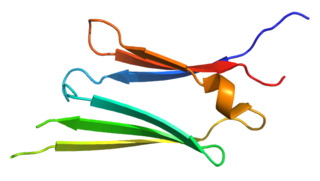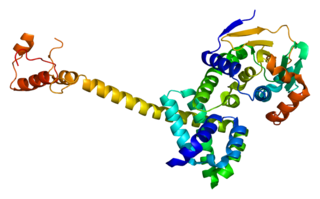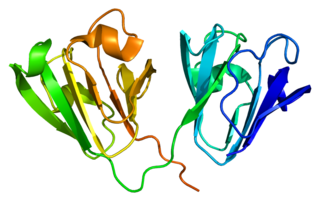In anatomy, a crystallin is a water-soluble structural protein found in the lens and the cornea of the eye accounting for the transparency of the structure. It has also been identified in other places such as the heart, and in aggressive breast cancer tumors. Since it has been shown that lens injury may promote nerve regeneration, crystallin has been an area of neural research. So far, it has been demonstrated that crystallin β b2 (crybb2) may be a neurite-promoting factor.

Heat shock protein 27 (Hsp27) also known as heat shock protein beta-1 (HSPB1) is a protein that in humans is encoded by the HSPB1 gene.

Integrin beta-3 (β3) or CD61 is a protein that in humans is encoded by the ITGB3 gene. CD61 is a cluster of differentiation found on thrombocytes.

Hsp90 co-chaperone Cdc37 is a protein that in humans is encoded by the CDC37 gene.

Alpha-crystallin B chain is a protein that in humans is encoded by the CRYAB gene. It is part of the small heat shock protein family and functions as molecular chaperone that primarily binds misfolded proteins to prevent protein aggregation, as well as inhibit apoptosis and contribute to intracellular architecture. Post-translational modifications decrease the ability to chaperone. Mutations in CRYAB cause different cardiomyopathies and skeletal myopathies. In addition, defects in this gene/protein have been associated with cancer and neurodegenerative diseases such as Alzheimer's disease and Parkinson's disease.

Nuclear transcription factor Y subunit beta is a protein that in humans is encoded by the NFYB gene.

Prostaglandin E synthase 3 (cytosolic) is an enzyme that in humans is encoded by the PTGES3 gene.

Laminin subunit alpha-1 is a protein that in humans is encoded by the LAMA1 gene.

Gamma-crystallin D is a protein that in humans is encoded by the CRYGD gene.

DnaJ homolog subfamily B member 1 is a protein that in humans is encoded by the DNAJB1 gene.

Lens fiber major intrinsic protein is a protein that in humans is encoded by the MIP gene.

Beta-crystallin B2 is a protein that in humans is encoded by the CRYBB2 gene.

Crystallin, gamma C, also known as CRYGC, is a protein which in humans is encoded by the CRYGC gene.

DnaJ homolog subfamily A member 1 is a protein that in humans is encoded by the DNAJA1 gene.

Heat shock protein beta-2 is a protein that in humans is encoded by the HSPB2 gene.

Beta-crystallin A3 is a protein that in humans is encoded by the CRYBA1 gene.

Gamma-crystallin S is a protein that in humans is encoded by the CRYGS gene.

Heat shock protein 75 kDa, mitochondrial is a protein that in humans is encoded by the TRAP1 gene.

Beta-crystallin A4 is a protein that in humans is encoded by the CRYBA4 gene.

Heat shock protein beta-6 (HSPB6) is a protein that in humans is encoded by the HSPB6 gene.























